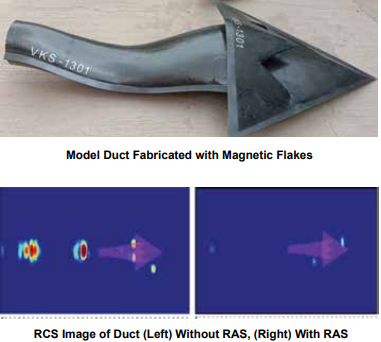SOURCE: RAUNAK KUNDE / NEWS BEAT / IDRW.ORG

The Defence Research and Development Organisation’s (DRDO) Aeronautical Development Establishment (ADE) has revealed a model duct fabricated with magnetic flakes for its upcoming Remotely Piloted Strike Aircraft (RPSA). This image shows the duct, along with Radar Cross Section (RCS) images of the duct with and without Radar Absorbing Material (RAS).
The RPSA is a 10-13 tonne drone, comparable to strike fighters in its capacity to carry heavy weaponry such as bombs, rockets, and missiles. Because they are remotely controlled, they can be built lighter and stealthier, allowing them to undertake even the riskiest missions.’
The model duct’s magnetic flakes are a crucial component of the RPSA’s stealth technology. These flakes absorb radar waves, making the drone more difficult to detect by enemy radar systems. The RCS images in the image demonstrate the effectiveness of the RAS, as the duct with RAS appears significantly less visible on radar than the duct without RAS.
The development of this model duct is a significant step forward for India’s RPSA program. The use of magnetic flakes represents a cutting-edge approach to stealth technology, and the successful testing of the duct paves the way for the development of a fully functional RPSA drone.
The RPSA is expected to play a vital role in the Indian Air Force’s (IAF) future operations. Its ability to carry heavy weaponry and operate at long ranges will make it a valuable asset for airstrikes and other offensive missions. Additionally, its stealth capabilities will allow it to penetrate enemy airspace undetected, giving the IAF a significant advantage in potential conflicts.
NOTE : Article cannot be reproduced without written permission of idrw.org in any form even for YouTube Videos to avoid Copy right strikes. Websites doing illegal reproductions will get DMCA and Legal Notices.